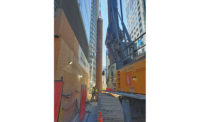The Shimmick Construction Co. team working on the test pile for the troubled foundation fix of the settling Millennium Tower in San Francisco has switched gears again, this time because of equipment troubles.
Last week, instead of completing the permanent pilot pile by installing the 24-in.-dia steel-encased concrete pile to a depth of about 270 ft, work resumed with the installation of a second outer 36-in.-dia casing for another future 24-in.-dia pile. The outer casing work was approved by the city based on the success of the installation of the first outer casing for the concrete pile, Oct. 12-13.
The second 36-in.-dia casing, installed Oct. 28-29—also to a depth of about 105 ft—was as successful as the first, reports Ronald O. Hamburger, a senior principal with Simpson Gumpertz & Heger and the structural engineer-of-record for the $100-million foundation fix, likened to putting a bumper jack next to a flat tire.
Accelerated Settling and Tilt
Accelerated settling and tilt—caused by the very perimeter pile upgrade intended to correct some 17 in. of building settlement—ceased after Aug. 20, when Hamburger halted the work.
The 645-ft-tall residential condominium, which remains occupied, has sunk a total of about 18 in. since its completion in 2008. The cause is consolidation of Old Bay Clay, according to Hamburger. The fix itself accounts for about 1 in. of the total settlement.
The pile upgrade calls for 52 concrete-filled steel-pipe piles within steel casings, along two sides of the building. By Aug. 20, Shimmick’s Legacy Foundations had installed thirty-three 36-in.-dia pile casings and six 24-in.-dia steel-pipe piles.
Five More Outer Casings
On Oct. 26, Hamburger submitted a proposal to the San Francisco Dept. of Building Inspection to resume installing five, 36-in.-dia casings along Mission Street using the approved revised procedures devised after worked halted Aug. 20, according to DBI.
DBI, the Engineering Design Review Team (EDRT) and Dan Brown and Associates (DBA), a geotechnical and foundation engineer with expertise in drilling, approved the proposal to move forward with the outer casings.
“Our position is based on the minimal overall settlement and tilt produced by the 36-in. pilot casing installed at location 33 earlier this month using the same modified procedure,” wrote Patrick O’Riordan, DBI’s Interim Director, in an Oct. 27 letter to members of the Millennium Tower Association and MTA’s general manager, James Zaratin.
Conditions for Support
The support was predicated on several conditions, including monitoring building settlement for the first additional casing in real-time, using a survey team and gradient strip mounted on the building façade. “Construction must cease immediately should settlement in the northwest corner exceed ¼-in., and Mr. Hamburger must immediately notify DBI, the EDRT and DBA,” stated the O’Riordan letter.
In addition, a DBA engineer had to be present “to observe, advise and provide guidance” to minimize settlement. Also, a DBI senior building inspector had to conduct a daily field inspection, primarily consulting with the special inspectors, to confirm that work met the building code.
Another condition was that if the second casing installation resulted in negligible settlement similar to the pilot casing installed at location 33, subsequent casing installations would be monitored by daily prism measurements of lateral tilt at the top of the structure. “This data will be transmitted to DBI, the EDRT and DBA at the end of each day and at the conclusion of installation of each casing,” said the letter.
Before Proceeding to Next Casing
Further, at the conclusion of each casing installation and before proceeding to the next casing, the retrofit team has to pause all drilling and casing installations until DBI, EDRT, DBA, Hamburger and the retrofit team could review the prism data and ensure the building remained within a safe range.
Finally, Hamburger is required to provide the weekly survey data collected by monitors on the mat foundation to track building settlement. “Should building settlement in the northwest corner exceed ¼-in. per installed casing, the retrofit work will cease immediately,” said the letter.
Shimmick has declined to comment on the work, but Hamburger reports replacement parts have been ordered. “We should be running the 24-in. test next week or the week after, depending on how the equipment repair goes,” he says.






Post a comment to this article
Report Abusive Comment